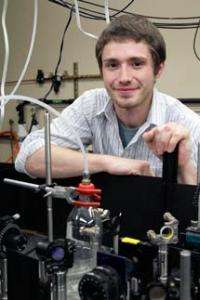Coke Bottle Quantum Physics

(PhysOrg.com) -- Don't be fooled by the collection of empty soda bottles in James Cryan's office at SLAC National Accelerator Laboratory. Cryan isn't a caffeine fiend—the cola bottles are for science. As a graduate student with the PULSE Institute for Ultrafast Energy Science, he is studying how nitrogen gas responds to stimulation by an optical laser, and he needed a container for the gas. Instead of ordering a cell and waiting for it to arrive, Cryan cast about for something close at hand—and happened upon one of the empty Coke bottles on his desk.
"It only cost us a dollar, so it's probably one of the cheapest things in the lab," Cryan said. "Plus, we recycled."
Nitrogen is a diatomic molecule; in a stick-and-ball picture, it looks like a dumbbell. In a cloud of nitrogen, the sticks aren't aligned in any particular way. But when a short optical laser pulse blasts the gas, the nitrogen molecules snap to attention, parallel with the pulse's electric field. Afterward, the molecules keep spinning, but not randomly—in a little while they fall into alignment again. Nitrogen molecules are quantum mechanical objects; their angular momentum, a property related to their rotation, can take on only certain values. If some of the molecules rotate at a certain speed, others are rotating twice as fast, others three times as fast, and so on. As the rotation continues, there are "revivals" of alignment—the molecules line up again and again.
Cryan wondered what would happen if he waited for a revival and kicked the molecules with a second pulse. He found that the effect adds up—the response is just as strong as if a twice-as-powerful pulse hit the molecules just once. This means multiple gentle kicks can create a very strong alignment. To get that same alignment with one kick would require a pulse so powerful it would ionize the molecules. In the past, researchers who want aligned gas molecules have worked around ionization by cooling the sample. Cryan's setup achieves aligned molecules at room temperature, and in a Coke bottle, no less.
The setup could be a tool for researchers studying coherence and decoherence, or how molecular behavior becomes choreographed and then falls out of synch. At first glance, the alignment, which lasts just one or two picoseconds, seems too short-lived to be caught by the 100-picosecond-long X-ray pulses of facilities like the Stanford Synchrotron Radiation Lightsource. But Cryan has found that the behavior averaged over time is more aligned, which means longer-pulse studies are possible.
For his own research, Cryan will bring his alignment tool to the ultrafast Linac Coherent Light Source once it's fully commissioned, to examine how its X-rays excite a gas. The LCLS will eject an electron from the inner shell of atoms in the gas; when a second electron falls into the vacant space, it releases a burst of energy, triggering the ejection of a third electron. Cryan wants to explore how this phenomenon, called Auger emission, depends on the angle of the incoming X-ray pulse.
"If we can get the molecules aligned, that's one less degree of complication," he said.
But in the state-of-the-art environs of the LCLS, Cryan will contain the gas in a plastic cell that supports variations in pressure.
"The Coke bottle probably won't make it to the LCLS," he said.
SWF video is available at today.slac.stanford.edu/featur … e_bottle_physics.swf
Provided by SLAC Today
















